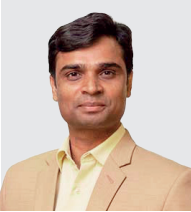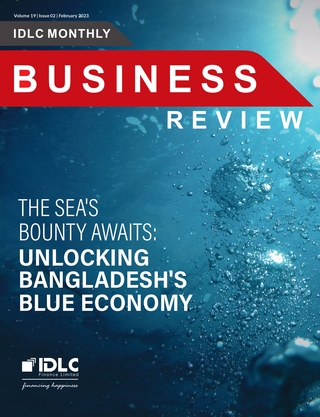
Expert Opinion On Exclusive Feature
Shikder Toushik Ahmed, Team MBR
Md. Mokhlesur Rahman is a fellow member of the national body of professional cost and management accountants, The Institute of Cost and Management Accountants of Bangladesh (ICMAB). He also completed the CA course from Hoda Vasi Chowdhury & Co. He has more than 14 years of experience in diversified sectors, including mobile, footwear, properties, healthcare, and so on. Before joining Edison Group, he worked for renowned groups of companies like Labaid Group. Team MBR was in a conversation with Mr. Rahman and was fortunate enough to receive his take on the footwear industry.
Shikder Toushik Ahmed: As per the latest annual report of the Export Promotion Bureau (EPB), Bangladesh exported USD 449.15 million worth of footwear (excluding leather) in FY2021–22, which has increased by 30.39% from the previous financial year. What are the factors that are, in your opinion, driving this phenomenal growth?
Md. Mokhlesur Rahman: This is a growing sector, and in the near future, the pace of growth will increase significantly. Local and foreign investors, as well as the government, are also focused on the footwear business. Because of rising demand from worldwide brands, Bangladesh’s synthetic footwear and sports shoe exports have grown at a pace of roughly 20% per year over the last five years.
The growth observed in the last year was slightly higher than in previous years due to a significant increase in demand following the COVID-19 pandemic. As a result of the COVID-19 pandemic, major suppliers like China, Vietnam, and Indonesia were affected, resulting in a failure to meet customer demands. Hence, buyers are shifting towards Bangladesh and other countries. During and after the COVID-19 pandemic, Bangladeshi factories continued their production. Also, the government provided support to run the production in terms of funding and healthcare. I think these are the major factors that have driven the growth of the last year. We believe that this sector will be the second-highest foreign currency-earning sector within a very short time period.
Shikder Toushik Ahmed: Edison Footwear is an export-oriented footwear manufacturer. What strategies does the company follow to stand out in the export market?
Md. Mokhlesur Rahman: Edison Footwear is an emerging, competent, and process-oriented footwear manufacturer working with different buyers like H&M, Decathlon, Wolverine, Fila, etc. Our major customer has been Decathlon from the very beginning. We are working with them and growing together as well. They are extremely conformist and process-oriented.
Our main strategy to stand out in the export market is to offer competitive prices to the customers while ensuring all types of compliance in terms of HR, environment, fire, chemicals, etc. To offer competitive prices, we need an efficient factory. We have undertaken different strategies to become an efficient factory and a major contributor in this sector. The strategies are faster decision-making, an enhanced efficiency level of more than 70%, the introduction of efficient processes, continuous human skill upgradation, appropriate costing before offering a price, the introduction of automatic and semi-automatic machines, maintaining an ERP-controlled and compliant environment, and valuing our stakeholders (customers, team members, and partners).
Shikder Toushik Ahmed: Leather and leather goods account for 1.90% of our export basket, while ready-made garments contribute nearly 85.00% on average. Do you think the leather and leather goods industry has the potential to diversify the export basket?
Md. Mokhlesur Rahman: There is a massive scope for Bangladesh in the leather and leather goods export business. China is moving towards high-tech industry products, so buyers are shifting their focus towards the sub-continent, especially India and Bangladesh. However, export volumes of leather and leather goods do not meet our expectations. Therefore, I think the footwear industry has the potential to diversify the export basket through synthetic footwear. However, leather exports have been hampered because there is no quality-assured finished leather manufacturer. So, we have to import the finished raw leather. Even after finishing processes in other countries, we sometimes have to import our exported leather. This issue must be fixed in order to increase leather goods exports.
Shikder Toushik Ahmed: China, Vietnam, and Indonesia are the world’s three largest footwear exporters, accounting for more than 70% of global footwear exports. What recommendations do you have for Bangladeshi footwear manufacturers in order for them to gain a competitive advantage and excel in the global market?
Md. Mokhlesur Rahman: To enjoy competitive advantages in the global market, Bangladeshi footwear manufacturers should form professional management teams, seek local and foreign investments, design efficiency-based complainant production units, and create backward linkages for raw materials to reduce lead time. Target prices should be set in line with the prices of raw materials while meeting the demands of the buyers. Effective business communication and marketing to the global market, appropriate costing and controlling, and training and development of human resources should also be ensured.
Lastly, I will say that we need to work directly with the brands to ensure more value addition in Bangladesh, as the middlemen, or agents, usually get a significant chunk as their cut from the profits the manufacturers make.
Shikder Toushik Ahmed: Changes in lifestyle have led to a higher demand for active footwear and luxury footwear in addition to traditional shoes. Is the footwear industry in Bangladesh capable of catering to this trend?
Md. Mokhlesur Rahman: We have just entered this segment. We are now manufacturing and exporting shoes primarily in the low to middle price range. There are just a handful of international shoe manufacturers in Bangladesh. China and Vietnam are major producers of trendy footwear, including fly-knit and high-density styles. But I am confident that the expertise of our industry people and the ambitions of the government and the owners will help attract major buyers and begin the production of active and luxury footwear in addition to traditional shoes. Improving our capacity to meet this trend will require an additional two to three years.
Shikder Toushik Ahmed: The footwear industry in Bangladesh was largely impacted by the outbreak of COVID-19. How is the industry performing currently?
Md. Mokhlesur Rahman: After the COVID-19 pandemic, orders fell by almost 30% to 35% in this industry due to the worldwide economic downturn, especially the staggering inflation in Europe and America. The war between Russia and Ukraine also deteriorated the purchasing power of the customers. Therefore, shoe sales fell drastically, and buyers 26 of 36 reduced their inventory by around 50%. At present, the economic situation in Europe and other countries is gradually improving, and our order level is picking up as well. However, our full capacity is still not being utilised. We are forecasting that the year 2023 will be challenging. This year, we need to sustain by increasing efficiency and reducing costs. We hope that, from next year on, our optimal capacity will be filled up, and we can start operating in full swing.
Shikder Toushik Ahmed: Cheap labour is a factor that is common for most of the industries that operate in Bangladesh, including the footwear industry. Which other factors do you believe are prevalent, and which can be leveraged to help the industry thrive?
Md. Mokhlesur Rahman: There are a great number of existing additional factors that could be used to improve the industry. Some of these factors include announcing cash incentives, declaring footwear industry zones, offering tax-free benefits, rendering technical training, searching for new market opportunities, ensuring quota facilities in the US market, developing infrastructure, reducing the complexity of the bond and customs approval processes, establishing strong backward linkages, ensuring a shorter lead time, and arranging low-cost funding. All of these factors could be leveraged to improve the industry.
Shikder Toushik Ahmed: The leather processing industry has created controversy because of the chemicals and gases released in the process. What initiatives can the industry participants undertake to minimise the impact on the environment and suppress these controversies?
Md. Mokhlesur Rahman: The government has already designated a special zone in the Savar area for the leather processing industry and has also launched the central ETP. However, a 100% functional ETP needs to be ensured. In order to make ETP fully functional, it needs continuous monitoring from the government, a strong desire from the industry participants, and the implementation of expert management. Subsequently, the introduction of new technologies and machines is required to reduce the adverse impact of chemicals. In the leather processing industry, direct and indirect conventional treatment of solid waste, research and innovation in chemical management, proper cleaning, and better waste management can help combat the adverse effects of the chemicals.

The Sea's Bounty Awaits: Unlocking Bangladesh's Blue Economy
The blue economy concept has become an exhortation for sustainable development through the utilisation of ocean resources for economic growth, enhanced livelihoods, and employment while conserving the health of the environment. According to the United Nations (UN), the industry is worth between USD 3 and USD 6 trillion globally, with its strong ties to SDG-14 (Life Below Water) serving as a crucial reason for elevating this sector.
With around 710 kilometres of coastline, the blue economy offers numerous opportunities for Bangladesh, particularly in the sectors of fisheries, shipping, tourism, natural resources, and oil and gas. The blue economy has the potential to make a substantial contribution to economic growth and enhance the quality of life for the people residing in Bangladesh’s coastal regions.
Expanding ocean-centric industries will bring a new perspective to our economic prosperity. At the same time, the unplanned proliferation of economic activities will be the cause of marine ecosystem deterioration and biodiversity loss, causing significant harm to low-income coastal residents. Understanding and effectively managing the numerous facets of marine sustainability is crucial to reaping the sea’s bounty.
Md. Shah Jalal
Editor
IDLC Monthly Business Review